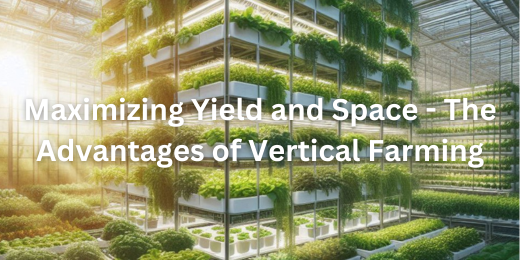
Maximizing Yield and Space – The Advantages of Vertical Farming
Benefits of Vertical Farming
Introduction to Vertical Farming
Vertical farming is a cutting-edge agricultural method that revolutionizes traditional farming practices. Unlike conventional horizontal farms, vertical farms make efficient use of space by stacking layers of crops vertically.
This innovative approach allows for the cultivation of a wide variety of crops in a significantly smaller footprint, making it particularly advantageous in densely populated urban areas where land is scarce.
Furthermore, vertical farming incorporates advanced technologies like hydroponics or aeroponics, where plants are grown in nutrient-rich water or in a mist environment, respectively. These methods reduce the need for soil and make it possible to grow crops year-round, independent of weather conditions.
The controlled indoor environment of vertical farms also minimizes the reliance on harmful pesticides and herbicides, resulting in cleaner and more sustainable agricultural practices. Embracing the benefits of Vertical Farming not only addresses the challenges of food security but also presents a promising solution for a more sustainable and resilient agricultural future.
Space Efficiency: Utilizing Vertical Space for Crop Growth
Vertical farming, a pioneering method in agriculture, capitalizes on space efficiency by stacking crops in vertical layers. Unlike traditional horizontal farms, which require vast expanses of land, vertical farms make the most of limited space. This approach is particularly valuable in densely populated urban areas, where arable land is scarce.
By utilizing shelves or racks to grow crops upwards, vertical farming multiplies the potential yield per square meter. This not only addresses the challenge of space constraints but also enhances the overall productivity of farming operations. Moreover, vertical farms employ advanced technologies like hydroponics or aeroponics, enabling crops to flourish without soil, further optimizing the use of space.
Welcoming the benefits of Vertical Farming through space-efficient practices not only revolutionizes conventional agriculture but also holds immense promise for sustainable food production in a rapidly urbanizing world.
Optimizing Light and Nutrient Distribution
Optimizing light and nutrient distribution is a cornerstone of the benefits of Vertical Farming. Vertical farms meticulously control environmental conditions to ensure crops receive the ideal amount of light and nutrients. Advanced LED lighting systems simulate natural sunlight, promoting plant growth while minimizing energy consumption.
Additionally, the precise delivery of water, nutrients, and oxygen to the root systems through hydroponics or aeroponics guarantees plants receive essential nourishment without waste. This level of control minimizes resource usage, resulting in more sustainable and eco-friendly farming.
The precise management of these factors contributes to faster crop growth, increased yields, and improved quality. Vertical farming’s focus on optimizing light and nutrient distribution not only enables the efficient use of resources but also allows crops to thrive in a controlled, pest-free environment. As a result, vertical farming promises a future of consistent, high-quality, and sustainable food production.
Reducing Environmental Impact through Vertical Farming
Vertical farming stands at the forefront of reducing environmental impact in agriculture. This innovative method employs controlled indoor environments, significantly diminishing the need for pesticides and herbicides. By creating a closed, sterile space, vertical farms mitigate the risk of pests and diseases, promoting cleaner and more sustainable farming practices.
Additionally, vertical farming minimizes water usage compared to conventional farming methods. Through precise systems like hydroponics, which recirculates water efficiently, and aeroponics, which uses mist to deliver nutrients, vertical farms achieve optimal resource conservation.
Moreover, vertical farming greatly reduces transportation emissions as these farms can be established in or near urban centres, reducing the distance food needs to travel. This leads to fresher produce with a markedly lower carbon footprint. Embracing the benefits of Vertical Farming not only addresses food security but also pioneers a more environmentally responsible and sustainable future for agriculture.
Year-Round Crop Production: Overcoming Seasonal Limitations
Vertical farming heralds a significant stride in agriculture by enabling year-round crop production, effectively overcoming the constraints imposed by seasonal changes. Unlike traditional farming that is dependent on specific weather conditions, vertical farms create a controlled environment where temperature, humidity, and light levels are meticulously regulated.
This means that crops can be cultivated regardless of the external climate. Advanced LED lighting systems simulate natural sunlight, ensuring plants receive the required light for photosynthesis even during winter months. Additionally, the vertical stacking of crops allows for efficient use of space, further maximizing year-round production.
This breakthrough not only addresses food scarcity during off-seasons but also reduces the need for long-distance transportation of produce. Welcoming the benefits of Vertical Farming for year-round crop production presents a game-changing solution to enhance food security and stability in the face of climate variability.
Maximizing Yield and Profitability in Vertical Farming Practices
Maximizing yield and profitability in vertical farming practices is the pinnacle of the benefits of Vertical Farming. By employing advanced techniques and technologies, vertical farms can significantly increase crop yields in a smaller footprint compared to traditional farms. The controlled environment allows for precise regulation of factors like light, temperature, and humidity, optimizing conditions for plant growth.
This meticulous control leads to faster growth rates and more harvests per year. Additionally, vertical farming minimizes resource wastage through methods like hydroponics and aeroponics, ensuring that plants receive exactly the nutrients they need. These practices not only enhance productivity but also reduce costs associated with soil, water, and pesticides.
The year-round production capability of vertical farms further maximizes profitability, providing a consistent supply of fresh produce. Embracing the benefits of Vertical Farming through strategic practices not only revolutionizes agriculture but also promises a more sustainable and economically viable future.